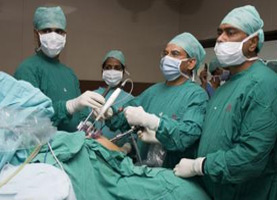
Laparoscopic surgery, also called minimally invasive surgery (MIS), is a modern surgical technique
in which operations in the abdomen are performed through small incisions (usually 0.3–1.5 cm) as compared
to the larger incisions needed during open or conventional surgery. By using state-of-the-art instruments
and high definition cameras, minimally invasive techniques are displayed on flat panel monitors adding
magnification of the surgical elements.
Laparoscopic surgery includes operations within the abdominal or pelvic cavities.
Advantages
There are a number of advantages to the patient with laparoscopic surgery versus an open procedure. These include:
- Reduced blood loss, which reduces the chance of needing a blood transfusion.
- Smaller incision means smaller scars
- Less pain or discomfort
- Quicker return to normal function.
- Less pain, leading to less pain medication needed.
- Hospital stay is less, and often with a same day discharge.
- Reduced exposure of internal organs to possible external contaminants thereby reduced risk of acquiring infections.

Disadvantages
While laparoscopic surgery is clearly advantageous in terms of patient outcomes, the procedure is more difficult from the surgeon’s perspective when compared to traditional, open surgery:
- The surgeon has limited range of motion at the surgical site resulting in a loss of dexterity
- Poor depth perception
- The surgeon must use tools to interact with tissue rather than manipulate it directly with their hands. This limitation reduces tactile sensation, making it more difficult to feel tissue (sometimes an important diagnostic tool, such as when palpitating for tumors)
- The tool endpoints move in the opposite direction to the surgeon’s hands due to the pivot point, making laparoscopic surgery a non-intuitive motor skill that is difficult to learn.